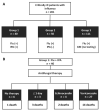The Impacts of Aspergillosis on Outcome, Burden and Risks for Mortality in Influenza Patients with Critical Illness
- PMID: 34829211
- PMCID: PMC8620692
- DOI: 10.3390/jof7110922
The Impacts of Aspergillosis on Outcome, Burden and Risks for Mortality in Influenza Patients with Critical Illness
Abstract
Previous studies have revealed higher mortality rates in patients with severe influenza who are coinfected with invasive pulmonary aspergillosis (IPA) than in those without IPA coinfection; nonetheless, the clinical impact of IPA on economic burden and risk factors for mortality in critically ill influenza patients remains undefined. The study was retrospectively conducted in three institutes. From 2016 through 2018, all adult patients with severe influenza admitted to an intensive care unit (ICU) were identified. All patients were classified as group 1, patients with concomitant severe influenza and IPA; group 2, severe influenza patients without IPA; and group 3, severe influenza patients without testing for IPA. Overall, there were 201 patients enrolled, including group 1 (n = 40), group 2 (n = 50), and group 3 (n = 111). Group 1 patients had a significantly higher mortality rate (20/40, 50%) than that of group 2 (6/50, 12%) and group 3 (18/11, 16.2%), p < 0.001. The risk factors for IPA occurrence were solid cancer and prolonged corticosteroid use in ICU of >5 days. Group 1 patients had significantly longer hospital stay and higher medical expenditure than the other two groups. The risk factors for mortality in group 1 patients included patients' Charlson comorbidity index, presenting APACHE II score, and complication of severe acute respiratory distress syndrome. Overall, IPA has a significant adverse impact on the outcome and economic burden of severe influenza patients, who should be promptly managed based on risk host factors for IPA occurrence and mortality risk factors for coinfection with both diseases.
Keywords: aspergillosis; influenza; intensive care unit; mortality; outcome.
Conflict of interest statement
The authors declare no conflict of interest.
Figures




Similar articles
-
Characteristics and outcomes for pulmonary aspergillosis in critically ill patients without influenza: A 3-year retrospective study.J Infect Public Health. 2023 Dec;16(12):2001-2009. doi: 10.1016/j.jiph.2023.09.016. Epub 2023 Sep 28. J Infect Public Health. 2023. PMID: 37890223
-
[The clinical characteristics of severe influenza virus pneumonia complicated with invasive pulmonary aspergillosis: a retrospective study of 15 cases].Zhonghua Jie He He Hu Xi Za Zhi. 2020 May 12;43(5):437-443. doi: 10.3760/cma.j.cn112147-20200109-00013. Zhonghua Jie He He Hu Xi Za Zhi. 2020. PMID: 32450632 Chinese.
-
Invasive pulmonary aspergillosis is associated with cytomegalovirus viremia in critically ill patients - A retrospective cohort study.J Microbiol Immunol Infect. 2022 Apr;55(2):291-299. doi: 10.1016/j.jmii.2021.03.005. Epub 2021 Mar 31. J Microbiol Immunol Infect. 2022. PMID: 33840605
-
Invasive pulmonary aspergillosis in patients with influenza infection: A retrospective study and review of the literature.Clin Respir J. 2019 Apr;13(4):202-211. doi: 10.1111/crj.12995. Epub 2019 Mar 18. Clin Respir J. 2019. PMID: 30661296 Review.
-
Invasive pulmonary aspergillosis complicating severe influenza: epidemiology, diagnosis and treatment.Curr Opin Infect Dis. 2018 Dec;31(6):471-480. doi: 10.1097/QCO.0000000000000504. Curr Opin Infect Dis. 2018. PMID: 30299367 Review.
Cited by
-
Age difference of patients with and without invasive aspergillosis: a systematic review and meta-analysis.BMC Infect Dis. 2024 Feb 19;24(1):220. doi: 10.1186/s12879-024-09109-2. BMC Infect Dis. 2024. PMID: 38373908 Free PMC article.
-
Clinical and Microbiological Characteristics of Culture-Positive, Influenza-Associated Pulmonary Aspergillosis: A Single-Center Study in Southern Taiwan, 2016-2019.J Fungi (Basel). 2022 Jan 4;8(1):49. doi: 10.3390/jof8010049. J Fungi (Basel). 2022. PMID: 35049989 Free PMC article.
-
Diagnosis and Treatment of Fungus and Virus Interaction.J Fungi (Basel). 2022 Jun 10;8(6):620. doi: 10.3390/jof8060620. J Fungi (Basel). 2022. PMID: 35736103 Free PMC article.
References
LinkOut - more resources
Full Text Sources

